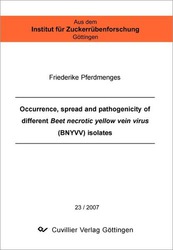| Areas | |
|---|---|
| Serie de libros (96) |
1378
|
| Nachhaltigkeit |
3
|
| Gesundheitswesen |
1
|
| Letra |
2364
|
| Ciencias Naturales |
5406
|
| Matemática | 229 |
| Informática | 319 |
| Física | 980 |
| Química | 1363 |
| Geociencias | 131 |
| Medicina humana | 243 |
| Estomatología | 10 |
| Veterinaria | 108 |
| Farmacia | 147 |
| Biología | 835 |
| Bioquímica, biología molecular, tecnología genética | 121 |
| Biofísica | 25 |
| Nutrición | 45 |
| Agricultura | 1004 |
| Silvicultura | 201 |
| Horticultura | 20 |
| Ecología y conservación de la tierra | 148 |
| Ciencias Ingeniería |
1793
|
| General |
98
|
|
Leitlinien Unfallchirurgie
5. Auflage bestellen |
|
Erweiterte Suche
Occurrence, spread and pathogenicity of different Beet necrotic yellow vein virus (BNYVV) isolates (Volumen 23) (Tienda española)
Friederike Pferdmenges (Autor)Previo
Indice, Datei (46 KB)
Lectura de prueba, Datei (170 KB)
Rhizomania (beet necrotic yellow vein virus, BNYVV) represents an important sugar beet disease, which is transmitted by the biotrophic plasmodiophoromycete Polymyxa betae. As long as the disease is not controlled it can lead to yield losses up to 90%. To date yield losses due to BNYVV infestation are inhibited by cultivating resistant sugar beet genotypes, which restrict the virus replication and translocation from infected hair-roots to the taproot. The BNYVV resistance is provided in marketable sugar beet varieties by two major resistance sources (Rz1 and Rz2 which either occur singular or in combination). But meanwhile on sugar beet genotypes carrying one (Rz1) as well as two resistance genes (Rz1+Rz2) resistance breaks could be observed at several BNYVV A-type infected sites in the USA and in Spain. To confirm these observations a 12 weeks greenhouse resistance test with three different cultivars (two partial resistant genotypes containing either Rz1 or Rz1+Rz2 resistance sources as well as a susceptible genotype) under standardized conditions with naturally infested soils from 6 locations was performed. The single resistance (Rz1) was compromised in soils from Spain (D), France (P-type, RNA-5 containing), and the USA (IV and MN); in reference soils from Italy (R, A-type) and Germany (GG, B-type) Rz1 resistant sugar beets were not affected. Overcoming of Rz1+Rz2 resistance after 12 weeks could only be observed in D soil. Over and above the genomic region that encodes for the pathogenicity factor (P25) of the BNYVV RNA3 from beets grown in all soils was analysed. Previously suggested correlation between “valine” on position 67 of P25 and a higher virulencecould not be confirmed. Isolates in one of the soils as well as experiments previously published, where overcoming of resistance could be observed, contain several other aa67 than valine. Analyses of additional soil borne pathogens using ITS sequencing and database comparison showed the presence of three pathogens (Rhizoctonia solani Keskin, Fusarium sp., Pythium sp.). Synergism between BNYVV, Rhizoctonia solani Keskin and Pythium sp. could lead to severe virus symptoms and weight reductions particularly in the Spanish soil. To determine if resistance breaks are correlated with the BNYVV inoculum concentration a “Most Probable Number“(MPN) – tests was conducted where same soils as in the resistance tests were examined. Thereby, D soil revealed the highest BNYVV density, the GG soil on the other hand displayed 520 times lower MPN. In order to obtain information on the aggressiveness of particular virus isolates an additional MPN with Rz1+Rz2 genotypes was performed. Within this test D, IV, MN and P resulted again in high BNYVV densities even able to infect Rz1+Rz2 plants after 4 weeks cultivation. These results give strong evidence that high inoculum doses are not responsible for the observed resistance breaks. To prove this conclusion another experiment with normalise inoculum added to sterile soil was carried out. Within this test three time harvests were conducted after 4, 8 and 12 weeks. Obviously, a significant differentiation of virus isolate vs. genotype correlating to tap root weight was only observed after 12 weeks. Consistently, applying adjusted inoculum density, D, IV, MN and P produced the highest virus contents at 12 weeks. Thus, resistance breaks must be connected to high BNYVV pathogenicity and not to inoculum density. Additional, experiments were conducted to test the influence of viruliferous P. betae zoospore concentrations from various origins, carrying different BNYVV-types. But due to uncertainty how many of the zoospores are actually viruliferous, the data resulted in highly different outcomes, not correlating to the results from tests in naturally infected soil. Moreover, efforts were undertaken to shorten resistance tests and replace them with time saving artificial sugar beet leaf inoculation via co-infiltration of a BNYVV RNA3 encoding P25 infectious cDNA clone and a red fluorescing marker gene (mRFP). Although, the method itself worked very well in young sugar beet leaves, no differences concerning the sugar beet genotype could be detected. The expected variability of fluorescence intensity comparing susceptible and resistant sugar beet cultivars was not given.
| ISBN-10 (Impresion) | 3867275017 |
| ISBN-13 (Impresion) | 9783867275019 |
| ISBN-13 (E-Book) | 9783736925014 |
| Formato | A5 |
| Idioma | Inglés |
| Numero de paginas | 116 |
| Edicion | 1 |
| Serie | Aus dem Institut für Zuckerrübenforschung Göttingen |
| Volumen | 23 |
| Lugar de publicacion | Göttingen |
| Lugar de la disertacion | Göttingen |
| Fecha de publicacion | 29.01.2008 |
| Clasificacion simple | Tesis doctoral |
| Area |
Agricultura
|
| Palabras claves | resistance, virus, sugar, plant, beet, roots, Resistenz, Virus, Zucker, Pflanze, Rübe, Wurzeln |








